For more updates on Too Many Chefs, follow the tumblr here:
http://toomanychefs-game.tumblr.com/
This blog will remain for personal game dev thoughts and updates.
For more updates on Too Many Chefs, follow the tumblr here:
http://toomanychefs-game.tumblr.com/
This blog will remain for personal game dev thoughts and updates.
The past two days, I released my game on Hackathon Hackers, r/webgames, Game Jolt, and itch.io. The reception was overwhelming. As of the past 48 hours, 2000 players have attempted the game, including CS professors and Canadians! Not too shabby for an indie dev’s class assignment.

over 2,000 users in a single day!
My favorite moment was when two different friends reached out to me within the same hour, to let me know that both of their brothers advertised my game to them on their own accord!
To celebrate, I am releasing a new feature tonight: the leaderboard.
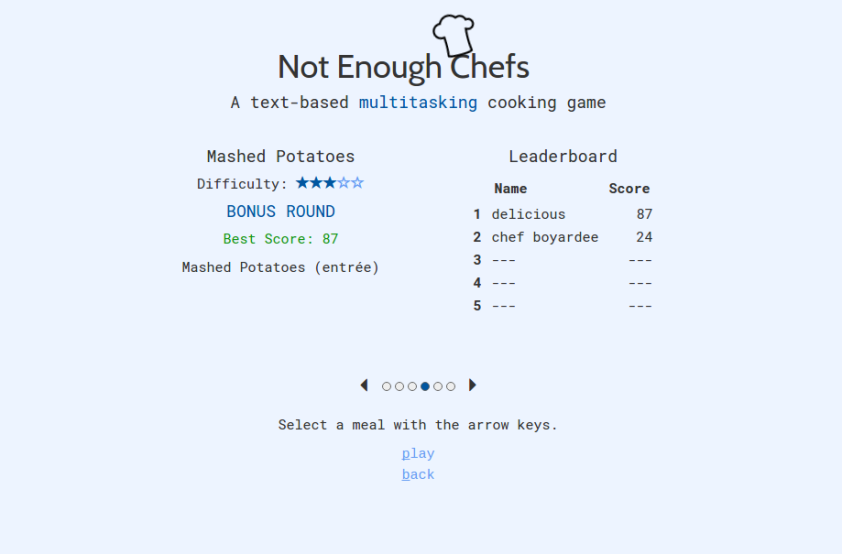
Step it up, chef boyardee.
For those technically inclined, the data is stored in Firebase, a free json-like data storage service. The top 6 times or scores for each mode (solo or party) are shown. Can you climb your way to the top? (Note that old times set before this update will not be reflected in the leaderboard, but any new records will!)
Stay tuned for future updates and development details! I’ll be adding more content both about the game and the development process here. Leave a comment if you’d like to request a feature or ask about the design process!
I recently picked up To the Moon, an indie adventure game developed in RPG Maker. As a role-playing fan and past user of the engine, I’ve decided to write on where it shines and where it falls short (spoiler-free!).
The first thing you’ll notice is the beautiful soundtrack. Composer-game-designer Kan Gao is a master at capturing the atmosphere through music (just listen to some of the tunes on bandcamp). The use of leitmotifs and character themes really enhances the experience.
Another area that really shines is the cinematography. Kan combines pixel art with beautiful painted backdrops. While much of the tilemap is from the default RPG Maker imageset, there are a lot of enhancements and additions, like new trees and plants and characters.
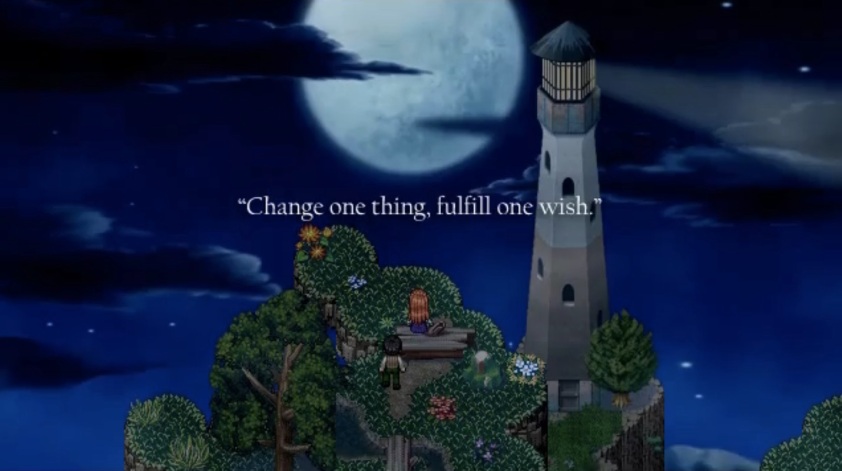
View of the lighthouse
Inside buildings, Kan makes effective use of “fog” to create nice lighting effects, another addition that is not present in most RPG Maker games. As a nice touch, you can turn lights on and off as well as interact with other objects.
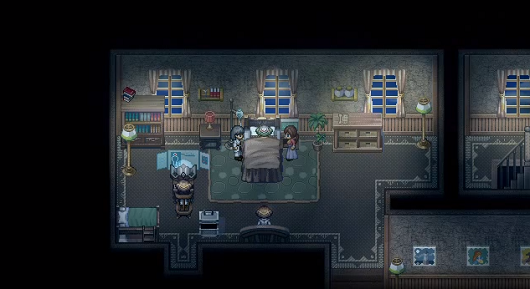
Lighting in the bedroom
But perhaps my favorite cinematographic detail happened during the flashbacks. When visiting past memories through interaction with “mementos,” the scene fades to white, leaving the memento in place. The next scene begins with the memento in the exact same location.
The storyline and characters are well-written, and the unique way of storytelling really works in a suspenseful and touching way. I won’t get into details to avoid spoilers, but there are some brilliant parts involving “time travel.”
There are a few places where To the Moon falls short. Some dialogue could use some more polish, and the UI menu is far too default RPG Maker to win me over. The gameplay, while not phenomenal, for the most part works. Clicking objects to walk around and examine is the mechanic of the whole game, though there are puzzles and minigames interspersed throughout. There are a few bugs with the pathfinding, however (such as characters stopping after stairs), and it’s sometimes unclear what areas are traversable or not.
That said, having used RPG Maker, Too the Moon is definitely one of the more polished pieces. Recommended if you’re looking for cinematic inspiration or a great story and are willing to overlook small bits of dialogue and less “gamey” gameplay!
Last Tuesday, I put the finishing touches on my text-based cooking party game, Too Many Chefs. The following is a post-mortem, focusing primarily on the concept of theming.
I set out on this design project with a single phrase: the adage “too many cooks spoil the broth.” Inspired by fast-paced minigame madness, as seen in Wario-Ware and Spaceteam, I strove to make my own: a cooperate text game that puts four chefs on one keyboard. In its essence, the game captured the idea of a busy kitchen filled with too many cooks.
After two tireless days of hacking away, I had a prototype up and running. It was a perfectly fun build: cooking minigames that had you typing commands, pushing arrow keys, and measuring out the right amount of oil or water to pour. Yet there was something missing, and it wasn’t just a proper UI. While pitched as a game of kitchen madness, it didn’t quite have the kitchen feel. So far, it was just another cooperative typing game, albeit one that smushed four players next to each other on one keyboard. Though players enjoyed the gameplay, it wasn’t quite cohesive… yet.
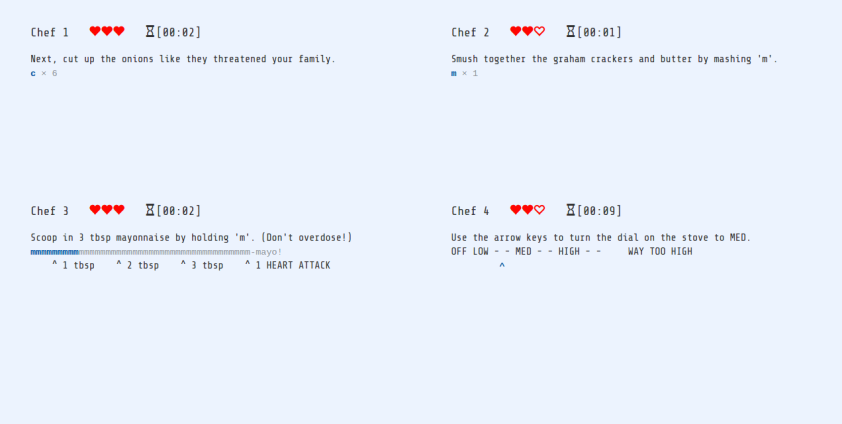
Iteration 1: boring UI
Over the next few iterations, I slowly added ingredients to the game, testing and tuning in response to player feedback. Here’s the truth I discovered: there is no one secret sauce. Theming and atmosphere is all about the little details. (This is by no means comprehensive, just a small list I found useful.)
In a text-heavy game, giving character to the chefs is very important. Blindly following instructions copied word-for-word from allrecipes.com would get tiring easily. Instead, I attempted to add diction that conveyed different personalities. In one recipe, a chef gets impatient and sets his food on fire; in others, players can name their food before they chop it up. I hoped to break up the monotony by adding little bits of humor here and there.
In addition to these narrative details, I added a stylish chef hat logo and even bought the domain http://toomanychefs.party, a much more presentable link than the first CMU andrew site I hosted on.
My first few attempts at recipes committed ungodly sins, like microwaving to defrost a piece of meat. After consulting a culinary enthusiast, I was reprimanded and told to correct it immediately. My food-fanatic friend did give me some excellent feedback, however. One suggestion was the addition of chef titles under the brigade system, like “Patissier” (pastry chef) and “Boulanger” (baker). In addition, instead of a hodgepodge of unrelated recipes (like fried rice and cheesecake), he had me put together 4-course meals that fit together, themed as a nice American brunch or French-Italian bistro. While these little details might be easily overlooked by the average player, they add a sense of completeness to those who are paying attention. And isn’t it more fun to play in a frantic, poorly run kitchen at a high-end restaurant?
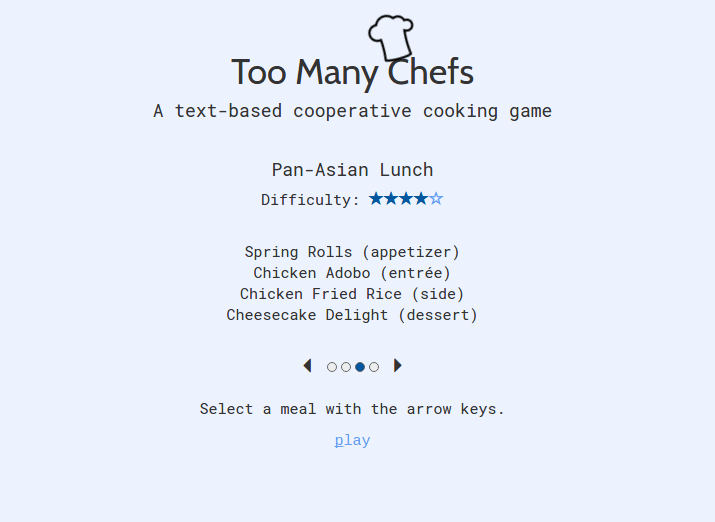
Iteration 8: logo and themed recipe select
Auditory feedback is a major feature. To capture the atmosphere of a fun cooking game, I borrowed a bossa nova theme from the Youtube Audio Library (tangent: how is it that every bossa nova song is perfect for cooking?). From this groove alone, playtesting became 5x more entertaining. Sound effects are also a key part of feedback, and I added sounds like pots and pans, frying oil, and pouring water, which added to the lively mood.
After looking up the pronunciation of a difficult recipe (Bouillabaisse), I was brilliantly inspired to use voice as feedback. I compiled a list of British voices for positive (“superb”, “well done”, “sublime”) and negative (“sloppy”, “disgraceful”, “no”) feedback. This added the humorous effect of hearing someone berate or praise you after every step.
In closing, theming is about the little details. Everything from visual to auditory to narrative tidbits can affect how people perceive a game. The more, the better– if you can surround your players with suggestions that they are in your world, then you will have succeeded.
With virtual reality titles popping up all over, it’s only time before the first big augmented or mixed reality project hits the scene. But as excited as I am about the video game scene, one part of me is itching to explore new territory: augmented reality as an aid to learning everyday tasks.
My interest in “gamification,” or the application of game design mechanics to real life, first piqued with Jesse Schell’s TED Talk. In it, he describes a future where toothbrushes and public transport award points for consumption. The idea of motivating good behaviors with fictional incentives has also been seen in apps like Habitica, which encourage forming good habits through in-game rewards and punishment.
Yet there’s still a disconnect between a virtual score and the actual benefits of doing good deeds. Assigning points to a task is extrinsic: the worth ascribes comes from an external motivation. But studies have found that intrinsic motivation, or the drive based off internal rewards, are much more effective. From experience, I’ve found that my most regular activities come from things I enjoy doing, not ones I force myself to because it’s “good for me.” Regular joggers and gym-goers will likely say the same thing.
And that’s where augmented reality fits in. One of my favorite short films, Sight, introduces a futuristic set of contact lenses that allows the protagonist to virtually skydive during aerobics, watch movies at any time, and even assists him during a date. But the most inspiring portion was the augmented cooking game. A minute into the video, the protagonist plays a delightful game of “Chef Master,” which guides the player into cutting a cucumber, providing instructions and even lines for where to cut.
While fictional, this game awards points and provides excellent feedback in the form of “GOOD” popups and sound effects. But the points are tied to the game itself, a consistency that most gamification apps lack. Achieving a high score directly correlates with a good chopping job, and likely translates into a delicious meal. Not only does the game motivate cooking well, it turns what could be a chore into something fun and exciting. And fun is intrinsically satisfying.
While technology still has a ways to go, I believe gamified augmented reality can really impact task learning, a largely unfilled niche. From cooking feedback to little cleaning games, the opportunities are endless. All that’s left is a platform for developers to seize upon. Fingers crossed for the Hololens, or even a comeback from Google Glass!
With the advent of Oculus Rift and other platforms, more and more titles are taking on the challenge of virtual reality. However, it’s clear that one feature of entertainment media, immersion, needs be much more prominent for players to buy into the new platform.
Immersion, or “spatial presence,” as defined by Jamie Madigan (The Psychology of Video Games), measures how closely a player feels to being “there” in a fictional world, not “here.” A player who fully enters the magic circle, suspending disbelief and picturing themselves in the character’s shoes, will probably enjoy a game more than one who scoffs at every missing pixel or graphical bug. Madigan lists a number of key game design tips to help with immersion, including using multiple sensory channels (sight and sound), completeness of senses, and a strong narrative. The key is to create an environment so realistic as to fool the player into thinking they are really in another world.
There are some excellent examples of really immersive experiences. One prank video shows a man flailing wildly after a friend pushes him during a roller coaster simulation. Another touching one sees a grown man crying of joy at being able to explore space. One of my favorite experiences was a tightrope walking game built at the Entertainment Technology Center (see a similar example video here). At first, seeing my friend breeze across a plank less than a foot off the ground, I was confident I could do better. Yet when I put on the headset, I immediately felt dizzy and shook from head to toe. As hard I tried to convince myself I was in no imminent danger, I lost my balance multiple times and barely made it across.

The Walk – Tightroping in VR
How had my friend done so much better? I did not understand the disparity until a year later, when for a research project I tested the inclination of 60 participants to kill to save in a virtual world.
The trolley problem, a famous philosophical thought experiment, placed 5 workers on a train track in the line of an incoming train. Pulling a lever would switch the train onto a different track with 1 worker. In either case, however, 1 or 5 workers would die. Should you pull the lever to kill 1 and save 5?
A variant of the problem took the abstracted murder and turned it into a “fat man” on a bridge. Now, the only way to save 5 was to physically push the man onto the tracks and stop the train. This was the problem we tested in virtual reality (see results here, or our demo video below).
The resultant range of immersion was astonishing. Some testers, fully immersed in the scenario, apologized or swore or attempted to talk to the worker. Others remarked about how fake the situation and controls seemed, and how they didn’t buy into the “PS1 graphics.” How could some testers be so enthralled, but others so distant?
The answer might lie in psychologist Auke Tellegen’s concept of “absorption,” or the “disposition… in which a person becomes absorbed in his or her mental imagery, particularly fantasy.” Here is a personality trait that induces openness in experiences, media and narrative, and even roleplaying! As an emotional reader and empathizer in books and movies, I likely found myself more immersed in the tightrope VR than my friend with lower absorption. Likewise, some testers’ personalities let them buy into the virtual trolley environment more than others.
The presence of a personality trait which might affect immersion raises a number of interesting questions for the future of virtual reality. When designing an immersive experience, what is the range of absorption for the audience? The average absorption? Should VR games be tailored towards a specific subset of the population, or designed for the general player? Future studies on the influence of absorption on immersion in VR could be revealing and insightful. While Madigan’s techniques for improving spatial presence are helpful, it’s good to know how exactly one’s audience will react.
Sometimes, the best parts of games can be the ones for which designers never intended.
A fun game is usually a sign of good design, good playtesting, good polish. It’s a constant iterative process to meet the impossible, unpredictable needs of the player. Even an unlimited budget and amount of time will sometimes fail to save a poor idea. So how do game designers do it? My hypothesis: a healthy mix of adaptability and luck.
To illustrate this point, I’ve dug up some of my fondest memories. The earliest begins with Hannah and the Pirate Caves, an action platformer back from my Neopets days. Hannah the hero is out to collect treasure and reach the end of the level, all the while dodging arrows, spikes, and dynamite traps.

Standard platforming goodness, and per se, it’s a thrilling game. But with the release of the level editor and experimentation of some avid players, new mechanics were born. One level in particular, by designer canadianstickdeath, positioned the player at the bottom of the map, without any floor tiles. At first, I thought the game had glitched (and it had). But playing through revealed that my player could still move, floating on the bottom of the map. I could not jump over the arrow traps, but by crashing into a crate, it would let me hop a short distance. With the right timing, the bug-filled level was playable, and boy was it fun! Inspired, I threw together my own level that capitalized on every bug I knew. It was challenging like hell, especially for those new to the glitches, but I had the time of my life.
On the topic of bugs, Super Smash Bros: Melee is a popular item. While enjoyable for casual play, the discovery of certain bugs led to higher tiers of skill. Terms like “wavedashing” (air dodging into the floor to slide) to “L-canceling” (shielding after an aerial attack to halve the recovery time) fell under the category of “tech skill,” coined to describe the technically ability to execute combinations of inputs. Many of these exploited bugs were clearly unintentional, yet the fanbase that has grown from watching professionals master these skills is incredible. Nintendo could hardly have guessed what would become of their simple fighting game.

Flash forward a few years to Super Mario Bros. Wii. A multiplayer sequel to the original series, this game added a brilliant mechanic: the ability to pick up your friends. Perhaps it was designed to save less-skilled friends from trouble and carry them across the map, but the real fun arises from throwing them off the map or into the enemies. Did the game intend for this competitive twist? My guess is no: not originally, but good playtesting led the developers to leave both cooperation and competition as alternatives, and perhaps even improve upon the healthy competition.

In all these examples, unexpected behavior led to surprisingly entertaining gameplay. So let’s incorporate it into our own designs. Okay, you’re probably wondering: how am I supposed to design a game such that players exploit things I didn’t intend to design? Well, the answer, as I mentioned, is twofold: adaptability and luck.
This past global game jam, my friends and I envisioned the myth of Sisyphus, a tragic Greek condemned by the gods to roll a boulder up a mountain for eternity. We thought it hilarious to make a game out of it, so we set out to it. We built a mouse version of the 1D game in Unity, whereby clicking and dragging the mouse up would exert a force on the boulder.
Upon playtesting, we realized immediately that the control scheme was terrible. It was too easy to misdrag left or right, adding a horizontal force that quickly toppled the boulder. But watching the boulder roll down to the side was hilarious. Instead of scrapping and fixing the bug, we adapted, changing the control scheme to WASD, moving the camera angle, and prototyping sideways movement. Now, the player could dart to the side and steady the boulder. But it was too easy, so we added in manual side drift: the boulder would randomly, for no reason, move to the left or right, forcing the player to catch it.

In the end, the players loved it. On top of the mechanics, we added the ability to unlock different aesthetics and enjoy the scenery. The trick: getting lucky with a fun mechanic, and adapting to capture unintended behavior. As designer Jason Vandenberghe puts it: “follow the fun!” Because now I can write down on my resume I forced a roomful of people to push a boulder up a hill for 50 days.
Novelty is a rare gem in games today. Too often, the industry sees repeats of the same formula: the same old 2D platformers and turn-based RPGs simply wrapped in a new set of shiny graphics. And while these structures are time-tested and sure to hold, a little creativity and surprise can go a long way to adding to the gaming experience.
Back in my early days, I stumbled upon a keyword that has since developed into the backbone of my design philosophy: the gimmick. Merriam-Webster calls it “an ingenious or novel mechanical device,” but this “gadget” can take various forms. Whether a core element of game mechanics, a twist on a storytelling trope, or a novel aesthetic choice, it is present in almost any example of good game design.
Take the gravity-bending VVVVVV. Rather than the typical “jump” mechanic, designer Terry Cavanagh replaced it with a “gravity reversal” button, a single concept that transformed the entire genre. Pokemon borrowed from RPG tropes, but added the ability to catch and train the very enemies you battled. Fez grabbed a 2D sprite and gave it the power to rotate in 3D space, bringing its generic platform world into a higher dimension. And one of my favorite series, The Legend of Zelda, incorporated one new tool per dungeon, like the boomerang or hookshot, that was necessary to solve the puzzles and defeat the boss. Each of these gimmicks is remarkably clean and simple, yet effected a completely unique experience.
I’ve since incorporated these ideas into my own game design. Great gimmicks are simple and fit easily into one-liners, an excellent way to brainstorm. I find the best gimmicks result from questioning assumed facts in game structures. For example, the entire design for Retrograde arose from a single question: what if a player in a platformer traveled left instead of right and lost powers instead of gaining them?
Finding new fun can be a challenge when almost any idea is recycled from some game out in the ether. Brainstorming creative gimmicks, let alone fun, is no easy task. But by focusing on a single twist instead of looking for quantity of features, a simpler game can outshine the complex.